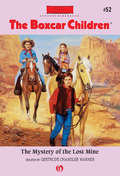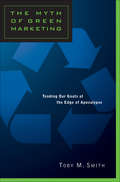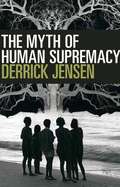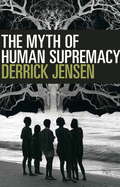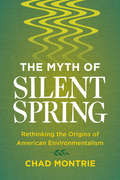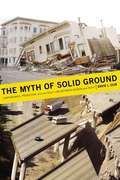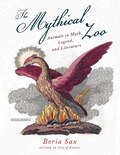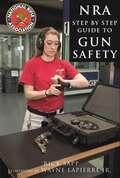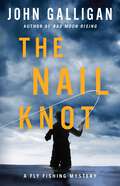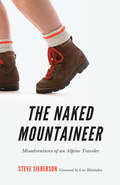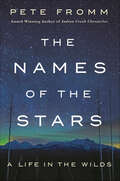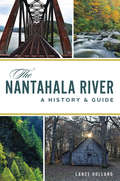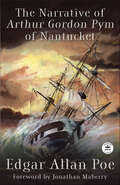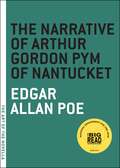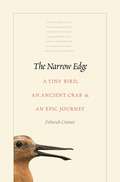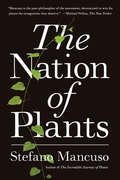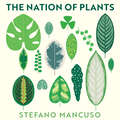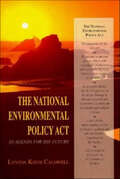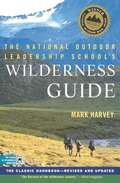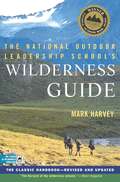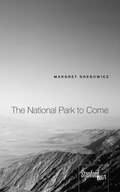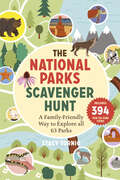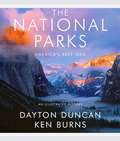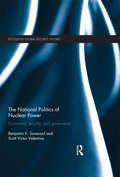- Table View
- List View
The Mystery of the Great Swamp
by Marjorie A. ZapfA young boy and his family living on the edge of the Okefenokee Swamp, Jeb discovers a strange and scary island he had never seen before. One day Jeb and his dog go out fishing and searching for the mysterious island with its beautiful Emerald Lake. A strong storm pushes Jeb to a place he had never been before. In his journey to find his way back home he unlocks the mystery to the Emerald Lake and the island.
The Mystery of the Lost Mine (Boxcar Children #52)
by Gertrude Chandler Warner Charles TangHenry, Jessie, Violet, and Benny used to live alone in a boxcar. Now they have a home with their grandfather, and they're going on a trip to the Arizona desert. There the Aldens learn about the legend of the Lost Dutchman Mine. Everyone thinks the mine is filled with gold. Can the Aldens find out if the legend is true, and if it is, who will find the gold?
The Myth of Green Marketing
by Toby SmithIn this groundbreaking study, Toby Smith analyses the role that social myths such as green marketing play in public understanding of the environmental crisis. This book introduces the concept of hegemony into environmental politics, using the concept to elucidate the political, economic, and social alliance that sustains our belief in industrial expansionism. The ecological crisis of the late twentieth century presents a challenge to the very foundations of this alliance. The hegemonic system reacts to a threat to its structure by producing social myths that provide a common sense understanding of the threat. Smith examines one such social myth, the contemporary phenomenon known as green marketing, and how it came to reinforce, rather than challenge, the ethics of productivism. By analysing green marketing as it relates primarily to the early 1990s corporate campaigns of companies such as McDonald's, Shell Chemicals, and Mobil Chemical Co., Smith demonstrates how these voices weave together an understanding of green consumerism using familiar language from economic and liberal democratic discourses. The Myth of Green Marketing is an original and important contribution to the field of environmental studies. As the first book on green marketing, it is sure to raise controversy with its unique discussion of the cultural and social aspects of environmental issues.
The Myth of Human Supremacy
by Derrick JensenIn this impassioned polemic, radical environmental philosopher Derrick Jensen debunks the belief in a hierarchy of nature and the superiority of humans. Vast and underappreciated complexities of nonhuman life are explored in detail; the paralysis of the scientific establishment on moral and ethical issues is confronted; and a radical new framework for assessing the intelligence and sentience of nonhuman life is put forth. A philosopher-poet of the environmental movement, Jensen sounds an urgent call for its liberation from human domination.
The Myth of Human Supremacy
by Derrick JensenIn this impassioned polemic, radical environmental philosopher Derrick Jensen debunks the near-universal belief in a hierarchy of nature and the superiority of humans. Vast and underappreciated complexities of nonhuman life are explored in detail--from the cultures of pigs and prairie dogs, to the creative use of tools by elephants and fish, to the acumen of caterpillars and fungi. The paralysis of the scientific establishment on moral and ethical issues is confronted and a radical new framework for assessing the intelligence and sentience of nonhuman life is put forth. Jensen attacks mainstream environmental journalism, which too often limits discussions to how ecological changes affect humans or the economy--with little or no regard for nonhuman life. With his signature compassionate logic, he argues that when we separate ourselves from the rest of nature, we in fact orient ourselves against nature, taking an unjust and, in the long run, impossible position.Jensen expresses profound disdain for the human industrial complex and its ecological excesses, contending that it is based on the systematic exploitation of the earth. Page by page, Jensen, who has been called the philosopher-poet of the environmental movement, demonstrates his deep appreciation of the natural world in all its intimacy, and sounds an urgent call for its liberation from human domination.From the Trade Paperback edition.
The Myth of Silent Spring: Rethinking the Origins of American Environmentalism
by Chad MontrieSince its publication in 1962, Rachel Carson’s book Silent Spring has often been celebrated as the catalyst that sparked an American environmental movement. Yet environmental consciousness and environmental protest in some regions of the United States date back to the nineteenth century, with the advent of industrial manufacturing and the consequent growth of cities. As these changes transformed people's lives, ordinary Americans came to recognize the connections between economic exploitation, social inequality, and environmental problems. As the modern age dawned, they turned to labor unions, sportsmen’s clubs, racial and ethnic organizations, and community groups to respond to such threats accordingly. The Myth of Silent Spring tells this story. By challenging the canonical “songbirds and suburbs” interpretation associated with Carson and her work, the book gives readers a more accurate sense of the past and better prepares them for thinking and acting in the present.
The Myth of Solid Ground: Earthquakes, Prediction, and the Fault Line Between Reason and Faith
by David L. UlinUlin shares his fascination with earthquakes, their science and how we think about them. A fascinating book; a conversational consideration of quakes and those who live through them.
The Mythical Zoo: Animals in Myth, Legend, and Literature
by Boria SaxA beautifully illustrated alternate taxonomy of the animal kingdom, based on mythology, literature, art, and other cultural realms: &“Charming.&” —ForeWord Sacred cows, wily serpents, fearsome lions, elegant swans, busy bees, and sly foxes—all are caricatures of the creatures themselves, yet they reflect not only how different cultures see the natural world around them but also how such cultures make use of their native animals. In this fun and thought-provoking book, historian and animal enthusiast Boria Sax argues for a classification of animals that goes beyond the biological to encompass a more meaningful distinction: tradition. From ants and elephants to tigers and tortoises, The Mythical Zoo weaves together a cross-cultural tapestry encompassing mythology, history, art, science, philosophy, and literature. The result is a beautifully illustrated, masterfully composed love letter to the animal kingdom.
The NRA Step-by-Step Guide to Gun Safety: How to Care For, Use, and Store Your Firearms
by Rick Sapp National Rifle AssociationHaving shaped our nation since its birth, guns are an integral part of American life. As more and more Americans choose to own firearms, it becomes increasingly important to educate them on proper shooting and handling techniques.Drawing on the National Rifle Association’s more than two centuries of shooting experience, as well as the collected knowledge of more than 55,000 certified instructors, The NRA Step-by-Step Guide to Gun Safety offers key-and life-saving-advice on using, caring for, and storing handguns, rifles, and shotguns. Packed with essential information and resources, including details on how propellants burn in cartridges, shooting etiquette on and off the range, and where to find a certified NRA shooting instructor, The NRA Step-by-Step Guide to Gun Safety will help reinforce the importance of safe gun-handling habits. Included is information on: The safest and most effective way to store and transport pistols, rifles, and shotgunsThe anatomy of the many kinds of guns availableThe proper way to reload any firearmThe best way to clean your gunProper use of eye and ear protectionThe correct clothing to wear while huntingWhether you are an experienced shooter or haven’t shot a round in your life, The NRA Step-by-Step Guide to Gun Safety will provide new and enlightening information that will make you, and your family, safer gun owners.Skyhorse Publishing is proud to publish a broad range of books for hunters and firearms enthusiasts. We publish books about shotguns, rifles, handguns, target shooting, gun collecting, self-defense, archery, ammunition, knives, gunsmithing, gun repair, and wilderness survival. We publish books on deer hunting, big game hunting, small game hunting, wing shooting, turkey hunting, deer stands, duck blinds, bowhunting, wing shooting, hunting dogs, and more. While not every title we publish becomes a New York Times bestseller or a national bestseller, we are committed to publishing books on subjects that are sometimes overlooked by other publishers and to authors whose work might not otherwise find a home.
The Nail Knot (A Fly Fishing Mystery #1)
by John GalliganThe going has gotten tough, and Ned ''Dog'' Oglivie has gone fishing. Fly fishing. For trout. All across America. At least until his money runs out . . .Driven by tragedy to turn his back on human society, the Dog is on a quest to fish himself into oblivion. And he's nearly made it. Playing the back highways of America in a wounded old RV . . . provisioned with a supply of peanut butter sandwiches, bad cigars, and vodka-Tang . . . armed with a loaded pistol (for when the money runs out) . . . the Dog is nearly at the end of his tether when he rolls into little Black Earth, Wisconsin, intending to fish the yellow sally stonefly hatch . . . and finds a body instead.Who killed Jake Jacobs, fellow fly fisher and late-coming agitator who was trying to save Black Earth Creek? Why was Jacobs disfigured in such a peculiar way? Why does the Dog give a damn? Can he rekindle his faith and interest in humankind? By caring about the death of a stranger, can the Dog recover his own life? Can he untie The Nail Knot?
The Naked Mountaineer: Misadventures of an Alpine Traveler
by Stephen C. Sieberson Lou WhittakerThe Naked Mountaineer recounts a series of solo journeys to some of the world’s most exotic peaks in places such as Switzerland, Japan, and Borneo. However, it is far from the typical heroic mountain-expedition book. Although Steve Sieberson did reach many summits, in most cases his travels were more memorable for what he encountered along the way than for the actual climbing. His real adventures involved peculiar people, strange foods, and tropical diseases, rather than pitons, ice axes, and carabiners. On the Matterhorn he met an English alpinist who reveled in naked selfies, he stumbled into a cockfight in a Balinese village, and on a volcano in Italy he was mistaken for a famous singer by an insistent fan.The Naked Mountaineer offers mountain-themed travel stories with a wide-eyed view of the world, while presenting irreverent commentary on climbers and their peculiar sport. These are rollicking tales, filled with the unexpected.
The Names of the Stars: A Life in the Wilds
by Pete Fromm“Finely tuned reflections” from an award-winning author “on [a] small but fully inhabited piece of the backwoods make this an adventure worth savoring” (Kirkus Reviews).At twenty years old, Pete Fromm heard of a job babysitting salmon eggs, seven winter months alone in a tent in the Selway-Bitterroot Wilderness. Leaping at this chance to be a mountain man, with no experience in the wilds, he left the world. Thirteen years later, he published his beloved memoir of that winter, Indian Creek Chronicles.Twenty five years later, he was asked to return to the wilderness to babysit more fish eggs. But no longer a footloose twenty year old, at forty-five, he was the father of two young sons. He left again, alone, straight into the heart of Montana’s Bob Marshall wilderness, walking a daily ten mile loop to his fish eggs through deer and elk and the highest density of grizzly bears in the lower forty-eight states.The Names of the Stars is not only a story of a trek through the wilderness but also an account of how an impulsive kid transformed into a father without losing his love for the wilds. From loon calls echoing across Northwood lakes to the grim realities of life guarding in the Nevada desert, through the isolation of Indian Creek and years spent running the Snake and Rio Grande as a river ranger, Pete seeks out the source of this passion for wildness, as well as explores fatherhood and mortality and all the costs and risks and rewards of life lived on its own terms.“Inspiring.” —Jim Lynch, author of Before the Wind“A coming-of-age book for adults; it is a tightrope walk between holding on to who you are and letting go a little for something you love even more.” —Kenyon Review
The Nantahala River: A History & Guide (Natural History)
by Lance HollandMost everyone who comes to western North Carolina has heard of the Nantahala, but few know its history. Long before it was a mecca for rafters and thrill seekers, it was traveled by naturalists and explorers from William Bartram to John C. Frémont. After the Cherokees were driven out, settlers arrived and began exporting the wealth of the mountains in the form of timber, talc and minerals. Tourists arrived on the Western Turnpike soon after, and the railroad brought more around 1890. The federal government began purchasing land for the new Nantahala National Forest, and the need for aluminum to fight World War II precipitated the construction of Fontana Lake and Nantahala Lake. Local author Lance Holland has crafted an enlightening and entertaining narrative history of this unique region.
The Narrative of Arthur Gordon Pym of Nantucket
by Edgar Allan PoeRum, a sailing ship, and a dare… …What could go wrong? Edgar Allan Poe’s only complete novel, The Narrative of Arthur Gordon Pym of Nantucket is one of the first adventure stories set in and around the Antarctic, which at the time was a place of mystery and the unknown. Pym takes us on an adventure across the seas to uncharted southern lands that are fraught with danger. With shipwrecks, murder, mutiny, and, yes, cannibalism, this tale has it all. First published in 1838, midway between Defoe’s Robinson Crusoe and Stevenson’s Treasure Island, Poe’s Pym echoes one and presages the other while delving even deeper into the darkness of men’s souls. This new edition, with a new Foreword by New York Times best-selling author and Bram Stoker Award winner Jonathan Maberry, brings the classic tale back to life. Not for the faint of heart, Poe’s novel, which inspired H.G. Wells, Jules Verne, H.P. Lovecraft, and many others, reflects the wonder and dangers of exploring the unknown.
The Narrative of Arthur Gordon Pym of Nantucket (The Art of the Novella)
by Edgar Allan PoeArthur Gordon Pym is a stowaway on the Nantucket whaling ship Grampus. During his journey he endures shipwreck, mutiny, starvation and cannibalism. Arthur is saved by the crew of Jane Guy and continues his adventures further south, eventually reaching the South Pole.
The Narrow Edge
by Deborah CramerThousands of ravenous tiny shorebirds race along the water's edge of Delaware Bay, feasting on pin-sized horseshoe-crab eggs. Fueled by millions of eggs, the migrating red knots fly on. When they arrive at last in their arctic breeding grounds, they will have completed a near-miraculous 9,000-mile journey that began in Tierra del Fuego. Deborah Cramer followed these knots, whose numbers have declined by 75 percent, on their extraordinary odyssey from one end of the earth to the other--from an isolated beach at the tip of South America all the way to the icy tundra. In her firsthand account, she explores how diminishing a single stopover can compromise the birds' entire journey, and how the loss of horseshoe crabs--ancient animals that come ashore but once a year--threatens not only the survival of red knots but also human well-being: the unparalleled ability of horseshoe-crab blood to detect harmful bacteria in vaccines, medical devices, and intravenous drugs safeguards human health. Cramer offers unique insight into how, on an increasingly fragile and congested shore, the lives of red knots, horseshoe crabs, and humans are intertwined. She eloquently portrays the tenacity of small birds and the courage of many people who, bird by bird and beach by beach, keep red knots flying.
The Nation of Plants
by Stefano MancusoIn this playful yet informative manifesto, a leading plant neurobiologist presents the eight fundamental pillars on which the life of plants—and by extension, humans—rests.Even if they behave as though they were, humans are not the masters of the Earth, but only one of its most irksome residents. From the moment of their arrival, about three hundred thousand years ago—nothing when compared to the history of life on our planet—humans have succeeded in changing the conditions of the planet so drastically as to make it a dangerous place for their own survival. The causes of this reckless behavior are in part inherent in their predatory nature, but they also depend on our total incomprehension of the rules that govern a community of living beings. We behave like children who wreak havoc, unaware of the significance of the things they are playing with. In The Nation of Plants, the most important, widespread, and powerful nation on Earth finally gets to speak. Like attentive parents, plants, after making it possible for us to live, have come to our aid once again, giving us their rules: the first Universal Declaration of Rights of Living Beings written by the plants. A short charter based on the general principles that regulate the common life of plants, it establishes norms applicable to all living beings. Compared to our constitutions, which place humans at the center of the entire juridical reality, in conformity with an anthropocentricism that reduces to things all that is not human, plants offer us a revolution.
The Nation of Plants: The International Bestseller
by Stefano MancusoAs plants see it, humans are not the masters of the Earth but only one of its most unpleasant and irksome residents. They have been on the planet for only about 300,000 years ago (nothing compared to the three billon years of plant evolution), yet have changed the conditions of the planet so drastically as to make it a dangerous place for their own survival. It's time for the plants to offer advice.In this playful, philosophical manifesto, Stefano Mancuso, expert on plant intelligence, presents a new constitution on which to build our future as beings respectful of the Earth and its inhabitants. These eight articles - the fundamental pillars on which plant life is based - must henceforth regulate all living beings.
The National Environmental Policy Act: An Agenda for the Future
by Lynton Keith Caldwell"The National Environmental Policy Act has grown more, not less, important in the decades since its enactment. No one knows more about NEPA than Lynton Caldwell. And no one has a clearer vision of its relevance to our future. Highly recommended." —David W. Orr, Oberlin CollegeWhat has been achieved since the National Environmental Policy Act was passed in 1969? This book points out where and how NEPA has affected national environmental policy and where and why its intent has been frustrated. The roles of Congress, the President, and the courts in the implementation of NEPA are analyzed. Professor Caldwell also looks at the conflicted state of public opinion regarding the environment and conjectures as to what must be done in order to develop a coherent and sustained policy.
The National Outdoor Leadership School's Wilderness Guide (Revised and Updated)
by Mark HarveyThe classic backpacker's handbook -- revised and updated -- providing expert guidelines for anyone who loves the outdoors. The Wilderness Guide brings the savvy of the world's most famous and respected outdoor organization to everyone -- from the 16 million backpacking Americans to the more than 265 million people, tender feet and trail-hardened hikers, who visit our national parks annually.
The National Outdoor Leadership School's Wilderness Guide: The Classic Handbook, Revised and Updated
by Mark HarveyThe classic backpacker’s handbook—revised and updated—providing expert guidelines for anyone who loves the outdoors.The Wilderness Guide brings the savvy of the world's most famous and respected outdoor organization to everyone—from the sixteen million backpacking Americans to the more than 265 million people, tenderfeet and trail-hardened hikers, who visit our national parks annually. It covers: -Selecting equipment—including discussions of the advantages and disadvantages of products such as the internal frame pack, lighter-weight boots, and freestanding tents -The latest “leave no trace” camping techniques -Traveling safely and sensibly—including vital information on maps, compasses, and tips on crossing difficult terrain -Backcountry cooking, with tips on building fires and tricks for making gourmet meals -Search-and-rescue techniques, including how to organize a self-sufficient search group and when to call in professional rescue teams Illustrated throughout with instructional drawings and photos and featuring lists of equipment, the Wilderness Guide is a must-have for anyone planning to explore the great outdoors.
The National Park to Come
by Margret GrebowiczHistorians of wilderness have shown that nature reserves are used ideologically in the construction of American national identity. But the contemporary problem of wilderness demands examination of how profoundly nature-in-reserve influences something more fundamental, namely what counts as being well, having a life, and having a future. What is wellness for the citizens to whom the parks are said to democratically belong? And how does the presence of foreigners threaten this wellness? Recent critiques of the Wilderness Act focus exclusively on its ecological effects, ignoring the extent to which wilderness policy affects our contemporary collective experience and political imagination. Tracing the challenges that migration and indigenousness currently pose to the national park system and the Wilderness Act, Grebowicz foregrounds concerns with social justice against the ecological and aesthetic ones that have created and continue to shape these environments.
The National Parks Scavenger Hunt: A Family-Friendly Way to Explore All 63 Parks
by Stacy TornioThis fun-filled guide shares an exciting scavenger hunt for every American National Park—featuring natural history factoids and fun and educational ways to get kids engaged with nature. Are you planning a trip to one of America's majestic national parks? The National Parks Scavenger Hunt will help you explore all 63 parks, from Acadia to Zion. A bucket list, game, and adventure all in one, this book will help adventurers of all ages learn fascinating facts about our nation's most iconic landmarks. By reading short descriptions of each item and them finding them, parents, caregivers, and kids alike can tally points in a friendly competition and make unforgettable memories along the way. Filled with colorful illustrations to help identify spectacular flora and fauna, you will want this in hand as you visit every park.
The National Parks: An Illustrated History
by Ken Burns Dayton DuncanThe companion volume to the new Ken Burns film: a magnificently illustrated history of the American National Park System. In a rich, deeply informative narrative, Dayton Duncan and Ken Burns examine how each new park was brought into the system.
The National Politics of Nuclear Power: Economics, Security, and Governance (Routledge Global Security Studies)
by Benjamin K. Sovacool Scott Victor ValentineThis book offers a comprehensive assessment of the dynamics driving, and constraining, nuclear power development in Asia, Europe and North America, providing detailed comparative analysis. The book formulates a theory of nuclear socio-political economy which highlights six factors necessary for embarking on nuclear power programs: (1) national security and secrecy, (2) technocratic ideology, (3) economic interventionism, (4) a centrally coordinated energy stakeholder network, (5) subordination of opposition to political authority, and (6) social peripheralization. The book validates this theory by confirming the presence of these six drivers during the initial nuclear power developmental periods in eight countries: the United States, France, Japan, Russia (the former Soviet Union), South Korea, Canada, China, and India. The authors then apply this framework as a predictive tool to evaluate contemporary nuclear power trends. They discuss what this theory means for developed and developing countries which exhibit the potential for nuclear development on a major scale, and examine how the new "renaissance" of nuclear power may affect the promotion of renewable energy, global energy security, and development policy as a whole. The volume also assesses the influence of climate change and the recent nuclear accident in Fukushima, Japan, on the nuclear power industry’s trajectory. This book will be of interest to students of energy policy and security, nuclear proliferation, international security, global governance and IR in general.

